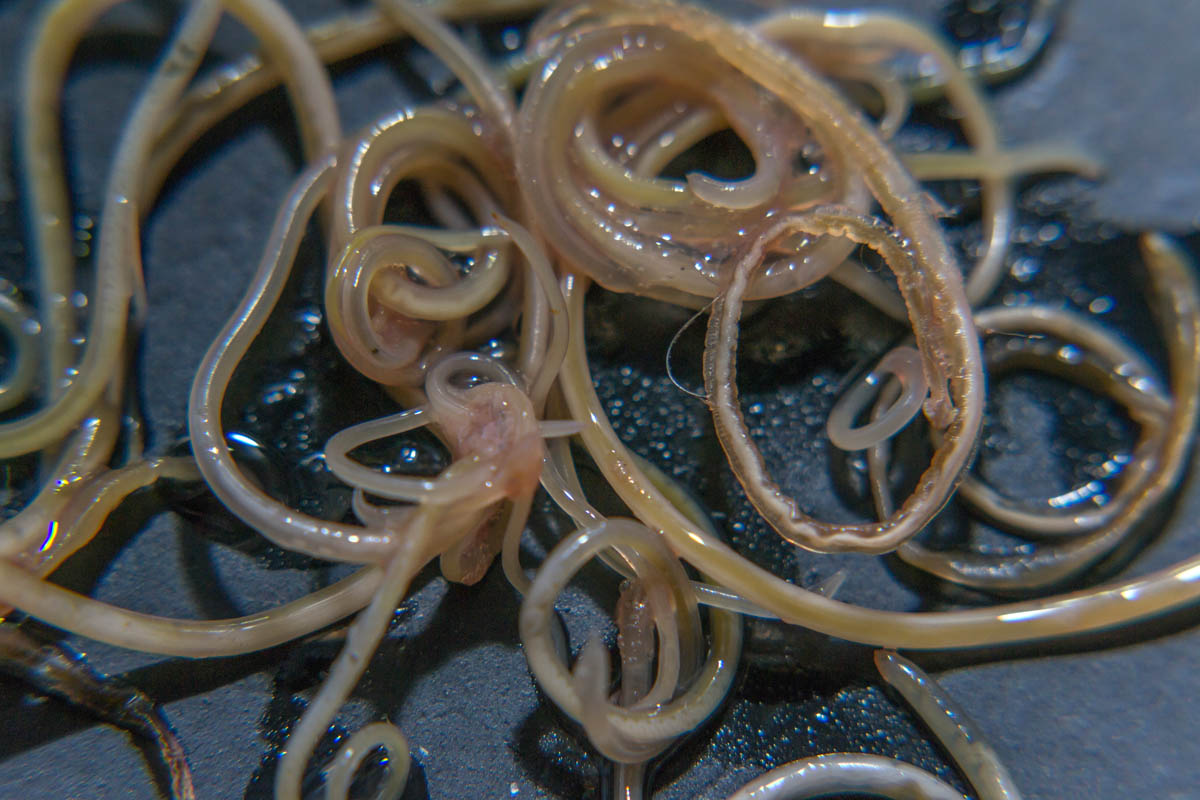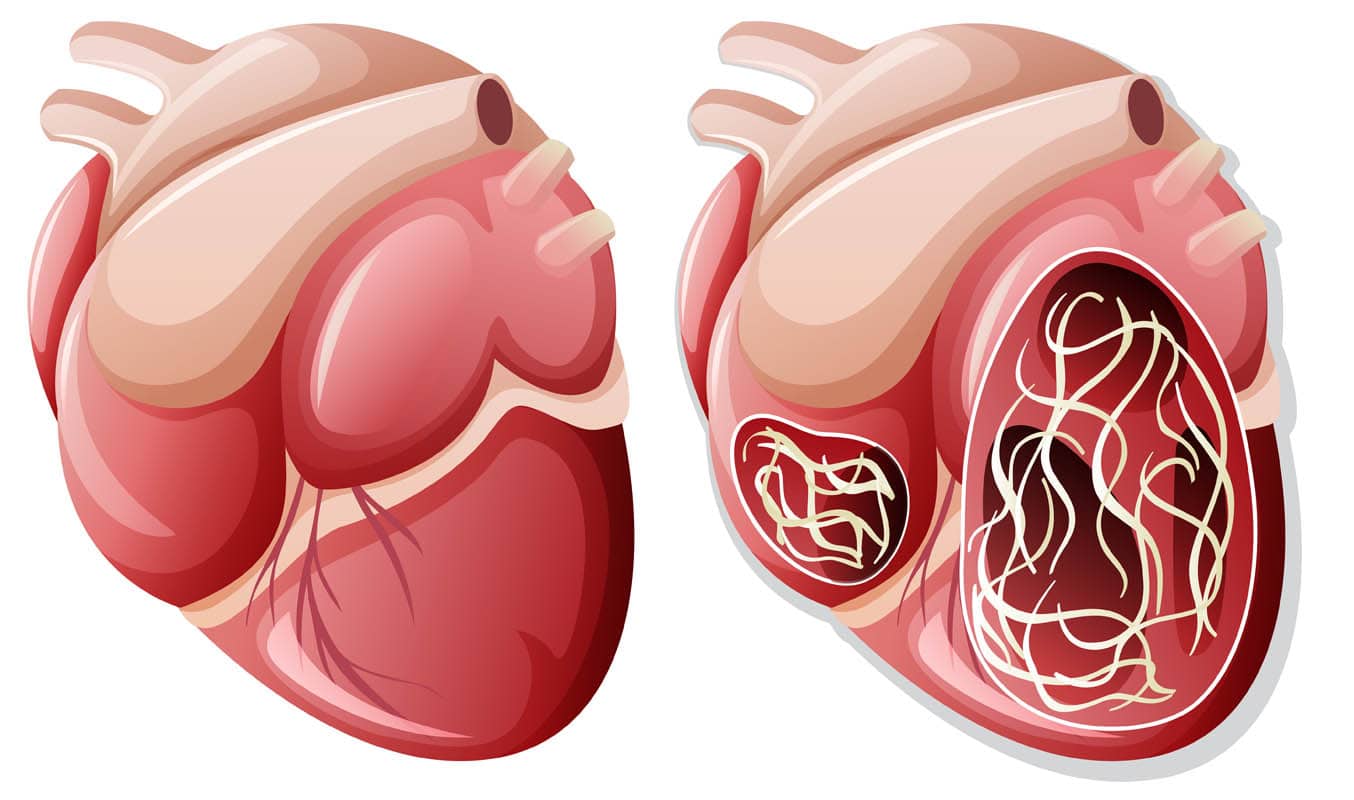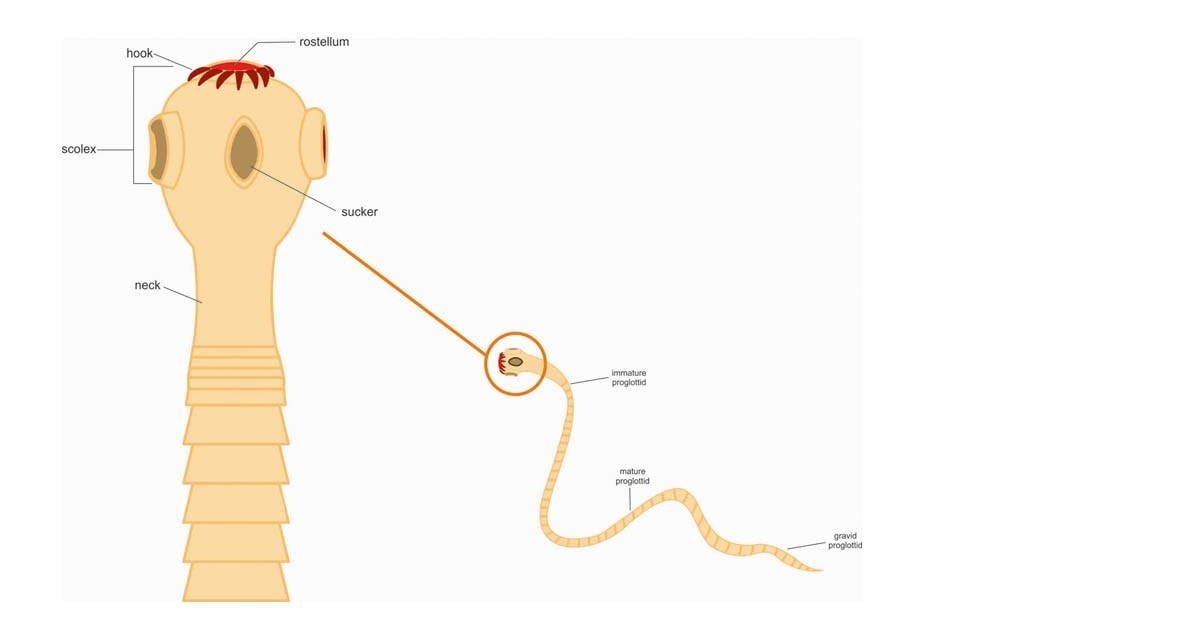About
Parasites are organisms that live off another organism. Cats are at risk of infection from several internal parasites, which can compete with the cat for food or cause tissue and organ damage.
Worms are the most common parasites to affect cats; other internal parasites include flukes and protozoa.
Roundworm

Roundworms are the most common internal parasite in cats. Two species infect cats, Toxocara cati, and Toxascaris leonina. Toxocara cati is more common in cats. They feed upon the intestinal contents, competing with the host for food. Roundworms are around 3 – 5 inches long and spaghetti-like in appearance.
Transmission:
- Transmammary transmission (Toxocara cati): When a cat is infected with roundworm, some larvae migrate to other tissues in the body where they encyst in the tissues. Pregnancy can re-activate larval cysts which migrate to the mammary glands and pass onto the kittens via the mother’s milk.
- Hunting: Rodents can act as intermediate hosts to roundworms and when a cat kills and consumes its prey.
- Environmental: Cats ingest roundworm eggs containing infective larvae from the environment such as soil, or when they come into contact with the faeces of an infected cat.
Roundworm symptoms:
- Poor coat condition
- Diarrhea
- Vomiting
- Pot-bellied appearance
- Severe cases can lead to pneumonia and intestinal and bowel blockage
Heartworm

Caused by Dirofilaria immitis, heartworms are a potentially fatal parasitic worm living in the pulmonary arteries, lungs and hearts of cats. Heartworms are nematodes, a type of roundworm; they are several inches long, thin and white.
Heartworms are a common parasite in dogs, although cats do become infected and may develop the disease. While cats are more resistant to heartworm infestations than dogs, cats, in particular, are vulnerable to heartworm, and even a small number can lead to death.
Transmission: Adult heartworms produce their young (microfilaria) which are present in the bloodstream of the infected animal. Mosquitoes act as an intermediate host to transmit the infection from one host to the next. When the mosquito feeds on the infected host, it ingests microfilaria circulating in the blood. Once inside the mosquito, microfilaria undergoes further maturation, which takes 10 – 14 days, at which time they become infective larvae. When the mosquito feeds from a cat or dog, it injects the larvae into the animal.
Heartworm symptoms:
- Coughing
- Wheezing
- Difficulty breathing
- Anorexia
- Vomiting
- Lethargy
- Weight loss
- Some cats show no signs at all, but die suddenly
Diagnosis:
Diagnosis of heartworms in cats is often difficult and not always 100% reliable. There are several tests which your veterinarian may perform, including;
- Antibody test: Detects antibodies made by the cat, to adult heartworm antigen, which may give false-positive results if the cat has had a prior heartworm infection that has cleared up. Also, the cat can have had microfilaria in the blood and removed this without them developing into adult worms.
- Antigen test: Detects the presence of heartworm antigen in the blood. This relies on the cat being infected with adult female heartworm, so may give false negatives if the cat is infected with male-only or immature heartworms.
- Echocardiogram: A non-invasive test that uses high-frequency sound waves to capture live images of the heart to look for the presence of heartworms.
- Radiography: May detect enlarged pulmonary arteries possibly with ill-defined margins and an enlarged right-hand side of the heart and lung changes.
- Microfilariae tests: Examination of a blood smear to look for the presence of microfilariae. Less than 20% of cats will have microfilaria in the blood as cats often only have one or two heartworms or they may be male-only or female-only, which would rule out mating of worms producing microfilaria. It is also possible that the cat’s immune system may be attacking and destroying any microfilaria present. Therefore a negative blood test will not rule out the presence of heartworms.
Tapeworm

Tapeworms are a specialised intestinal parasite known as Cestodes which feed on the intestinal contents of their host.
Transmission: Tapeworms need two hosts, the intermediate host which passes the cysticercoid around and the final host (your pet), where it develops into an adult tapeworm and lays its eggs. Dipylidium caninum is the most common tapeworm in cats followed by Taenia taeniaeformis. Tapeworms are hermaphroditic, which means they contain both ovaries and testes and are capable of reproducing on their own.
Dipylidium caninum:
The most common tapeworm found in cats. The cat flea is the intermediate host of dipylidium caninum. Eggs are passed in the faeces and eaten by flea larvae. Once inside the flea larvae, the egg hatches and becomes (cysticercoid). The flea larvae develop into an adult flea, which goes about its business of parasitising your pet and sucking blood. Your cat (or dog) then ingests the flea during grooming. Once inside the stomach, the flea is broken down, and the tapeworm is released. It hooks onto the small intestinal wall and develops into an adult tapeworm. Once it reaches maturity (in around 2 – 3 weeks) egg-filled segments break off and leave the body via the anus. These segments have the appearance of rice grains. These segments are motile (capable of movement).
Dried segments out they have the appearance of sesame seeds. They are then eaten by flea larvae, and so the cycle begins once again.
Taenia taeniaeformis:
The second most common tapeworm in to parasitise cats. Infection occurs when a cat eats rodents that contain the larval tapeworm.
Symptoms:
The presence of rice-like segments (proglottids) around your cat’s anus and in the environment, weight loss and poor coat condition.
Hookworm

Hookworms are a common intestinal parasitic worm found in dogs and cats, although they are less common in cats than they are in dogs.
Hookworms live in the intestine of the host and have teeth-like mouthparts which they use to attach themselves to the intestinal wall and feed off the host’s blood.
Transmission: Worm eggs can pass from a bitch to her unborn puppies via the placenta, it hasn’t been established if this is the case with feline hookworms yet.
Hookworm larvae can also be passed via breast milk from bitch to puppies. When a dog becomes infected with hookworms, most of them migrate to the small intestine, however, some enter other tissues of the body where they become dormant. During pregnancy, larvae migrate to the mammary glands and pass into the puppies via the milk. It hasn’t been established if this is the case with feline hookworms yet.
Hookworm eggs are passed in the cat’s stool and hatch into larvae within 2-5 days, depending on conditions. Larvae remain present in the moist environment of soil, and vegetation and can infect a cat via ingestion of larvae or burrowing onto the skin.
Symptoms:
When they suck blood from their host, they release an anticoagulant (a substance that prevents the blood from clotting). This results in black or bloody stools.
- Anaemia (weakness, pale gums)
- Dull coat
- In kittens, stunted growth
Other internal parasites
- Lungworm (Aelurostrongylus abstrusus and Capillaria aerophila)
- Giant kidney worm (Dioctophyma renale)
- Bladder worm (Capillaria feliscati)
- Stomach worm (Physaloptera spp. and Ollulanus tricuspid)
- Eye worm (Thelazia californiensis and Thelazia callipaeda)
- Lung fluke (Paragonimus kellicotti and Paragonimus westermani )
- Liver fluke (Opisthorchis felineus)
- Giardia (Giardia duodenalis)
- Cryptosporidium (Cryptosporidium spp.)
- Coccidia (Isospora rivolta and Isospora felis)
- Toxoplasma (Toxoplasma gondii)
Treatment
Worms and flukes: Fortunately, there are many products on the market to treat most parasitic worms, flukes and protozoa. Your veterinarian is the best person to speak to in regards to which product will suit your cat best.
Heartworm: There are no approved methods to treat heartworm in cats; the available treatments are dangerous. A single dead worm can be fatal in cats as it can break away and cause a blockage of the pulmonary artery (pulmonary embolism.
If there are no clinical symptoms, your vet may decide not to treat the cat and wait for it to clear the parasite in its own time.
Symptomatic cats will need supportive care such as a bronchodilator to open the airways, oxygen therapy, and intravenous fluids.
Adulticide treatment may be recommended for cats with clinical signs which are not responding to supportive care. Caparsolate is the drug used and kills adult worms. This carries risks, as a dead worm can result in a pulmonary embolism. Around 1/3rd of cats receiving treatment will face life-threatening complications as a result of the dying worms. Confinement will be necessary for a few weeks after treatment. Either way, if you choose to let nature take its course and hope that the worm lives out its lifespan within the cat, or if you use an adulticide, there are risks. These must be weighed up by your veterinarian before a decision is made. Surgical removal of the worms has been used in some cases.
Protozoa: Most asymptomatic cats will require no treatment. Cats with clinical signs will require supportive care such as intravenous fluids to treat dehydration and nutritional support while the cat’s immune system clears the parasite.
Can I catch parasites from my cat?
Tapeworm:
Yes and no. You cannot catch tapeworm directly from your cat, but if your cat has fleas, it is possible to catch tapeworm by accidentally swallowing a flea carrying the tapeworm cysticercoid.
Hookworms:
You can, although they can’t develop into the adult form as they do in cats. Infective larvae are found in the soil or sandy areas such as beaches or children’s sandpits. They can penetrate the skin, where they migrate through the body, causing a red, itchy skin eruption (cutaneous larva migrans or ground itch). Hookworm larvae cannot complete their life cycle and die in the epidermis.
Roundworms:
Toxocariasis is a disease in humans caused by infection of the roundworm egg. Most cases have been identified as those of T. canis although occasionally T. cati has been identified. In humans, roundworms can’t go past “stage 2” (larval stage). As with infection in rodents, the larvae migrate to various tissues in the body (causing a disease called visceral larva migrans or toxocariasis) including the lungs, brain, eyes, and liver.
- Ocular larva migrans (OLM): Larvae enter the eye, causing an inflammatory response, which leads to damage to the eye; in severe cases, it can result in blindness.
- Visceral larva migrans (VLM): Larvae migrate to the various organs and cause an inflammatory immune response which leads to damage to the organs.
- The larvae can remain alive for many months, causing damage by migrating through tissues.

